Chinoiserie
Flat chased silver “in the Chinese taste” enjoyed a brief period of remarkable popularity from the 1670’s to the early Queen Anne period. Silverware of normal European forms was decorated with charming scenes representing Chinamen, birds and Chinese landscapes. The concentration of nearly all surviving examples within this clearly defined period, and the similarity of decoration on objects bearing different makers marks, point to a specialist workshop not yet identified, to which silver was sent by goldsmiths or their customers for decoration. This charming decoration of Chinese figures, birds, foliage etc. is rarely found and adds considerably to the piece.
The fascination for “China style” decoration saw a revival in the middle of the 18th century due to the rise in trade with China and the rest of East Asia. Silverware from this period was associated with the rococo style and the exuberant, deeply embossed silverware from this period is quite stunning.
Chinoiserie persisted into the 19th and 20th centuries but declined in popularity. There was a notable loss of interest in Chinese-inspired décor after the death in 1830 of King George IV, a great proponent of the style. The First Opium War of 1839–1842 between Britain and China disrupted trade and caused a further decline of interest in the Oriental. China closed its doors to exports and imports and for many people chinoiserie became a fashion of the past.
As British-Chinese relations stabilized towards the end of the 19th century, there was a revival of interest in chinoiserie. Prince Albert, for example, reallocated many chinoiserie works from George IV’s Royal Pavilion at Brighton to the more accessible Buckingham Palace. Chinoiserie served to remind Britain of its former colonial glory that was rapidly fading with the modern era.
Chinoiserie
Flat chased silver “in the Chinese taste” enjoyed a brief period of remarkable popularity from the 1670’s to the early Queen Anne period. Silverware of normal European forms was decorated with charming scenes representing Chinamen, birds and Chinese landscapes. The concentration of nearly all surviving examples within this clearly defined period, and the similarity of decoration on objects bearing different makers marks, point to a specialist workshop not yet identified, to which silver was sent by goldsmiths or their customers for decoration. This charming decoration of Chinese figures, birds, foliage etc. is rarely found and adds considerably to the piece.
The fascination for “China style” decoration saw a revival in the middle of the 18th century due to the rise in trade with China and the rest of East Asia. Silverware from this period was associated with the rococo style and the exuberant, deeply embossed silverware from this period is quite stunning.
Chinoiserie persisted into the 19th and 20th centuries but declined in popularity. There was a notable loss of interest in Chinese-inspired décor after the death in 1830 of King George IV, a great proponent of the style. The First Opium War of 1839–1842 between Britain and China disrupted trade and caused a further decline of interest in the Oriental. China closed its doors to exports and imports and for many people chinoiserie became a fashion of the past.
As British-Chinese relations stabilized towards the end of the 19th century, there was a revival of interest in chinoiserie. Prince Albert, for example, reallocated many chinoiserie works from George IV’s Royal Pavilion at Brighton to the more accessible Buckingham Palace. Chinoiserie served to remind Britain of its former colonial glory that was rapidly fading with the modern era.
-

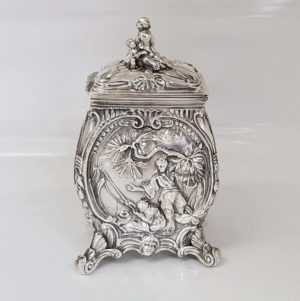
1761
Emick Romer
9755 George III Silver Chinoiserie Tea Caddy
Sold
A fine example of an antique silver caddy box of bombe form with a side hinged lid and standing on scrolling feet. The sides are embossed with charming scenes of Chinese daily life. The lid finial is in the form of a mother and baby. Weight 366 grams, 11.7 troy ounces. Height 16cm. Body measurements at maximum – width 9.2cm, depth 8cm. London 1761. Maker Emick Romer. Sterling silver.
-

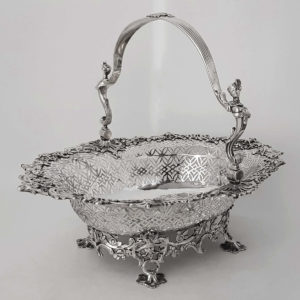
1758
Samuel Herbert And Company
9835 George II Silver Basket
£8,750
A magnificent George II silver basket of oval form with excellent quality hand cut pierced work and a Chinoiserie theme. This really is a very fine example. Both the upper border and bottom frieze are cast with flowers, scrolls, and Chinese face masks. The swing handle has a cast figure of a Chinese lady to both sides. The centre is beautifully engraved with a coat of arms within a large decorative cartouche. Very good weight and colour. Weight 1770 grams, 56.9 troy oz. Height 30cm (total including handle), 12cm (basket only). Top measures 38 x 32cm. London 1758. Maker Samuel Herbert & Co. Sterling silver.
-

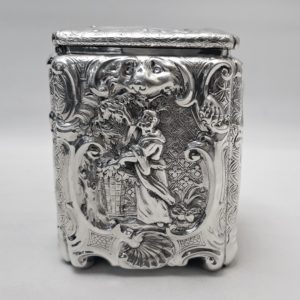
1849
Joseph Angell
10194 Antique Silver Caddy Box
£2,250
A very ornamental antique silver tea caddy of rectangular form having a side hinged lid and integral feet. The sides and top have embossed scenes of chinoiserie decoration with excellent quality hand engraved detail. The front and back panels contain a shaped scroll cartouche with the expressive face of a lion with his flowing mane and one paw outstretched to the top and, a shell within matted brickwork to the bottom – all this bears a striking similarity to the #9454 Edward Wakelin caddy dated 1748 in our archive collection. Weight 371 grams, 11.9 troy ounces. Height 13cm. Base measures 10.2 x 8.8cm. London 1849. Maker Joseph Angell. Sterling silver.
-

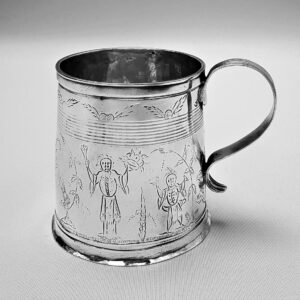
1692
John Cruttall
10355 William and Mary Antique Silver Mug
£3,350
A charming piece of chinoiserie silver. A rare early antique silver tankard of straight sided form with bands of reed to the top and a simple strap handle. Small size. The hand engraved decoration has a naive oriental scene incorporating Chinese people and exotic birds. To the front is a vacant cartouche with intertwined foliage. Contains 160ml. Weight 280g, 9 troy oz. Height 8.8cm. Diameter 7.4cm (top). London 1692. Maker John Cruttall. Sterling silver.
-

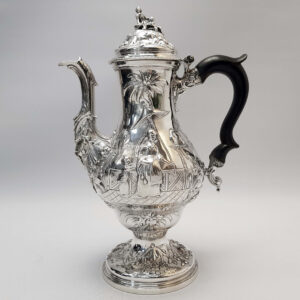
1767
Thomas Whipham & Charles Wright
10374 George III Antique Silver Coffee Pot
Sold
A rare and very charming early English silver coffee pot, embossed with Chinese figures and exotic birds and plants. With a tall and graceful baluster form, wooden scroll handle and a cast silver finial in the form of an oriental gentleman. To the front there is a small hand engraved armorial with motto “I’ll Defend”. Good patina. Contains 1250 ml. Weight 1127g, 36.2 troy oz. Height 31.5cm. Spread 21.5cm. London 1767. Maker Thomas Whipham & Charles Wright. Sterling silver.
-

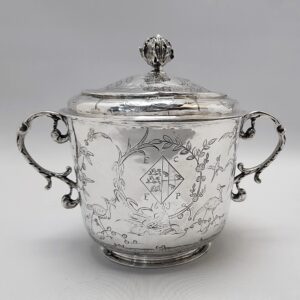
1683
Robert Cooper
10383 Charles II Antique Silver Porringer
Sold
A rare early English silver cup and cover with finely engraved chinoiserie decoration to the body and lid. Large size and good heavy weight. The fantastical Chinese forest landscape contains exotic long tailed birds and spidery plants depicted in beautiful hand chased ornament. To the front there is a widow’s armorial, owner’s initials, and the date “1683”. The shaped handles are typical of this early period. Weight 575g, 18.4 troy oz. Height 11.2cm (to rim), 17.5cm (to top of finial). Spread 21.8cm. Diameter 14.1cm. London 1683. Maker Robert Cooper. Sterling silver. 17th century.
-

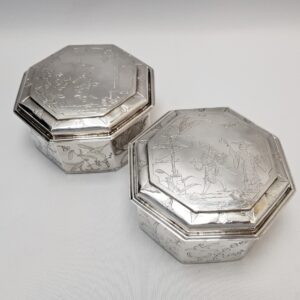
1680
Ralph Leake
10419 Pair of Charles II Antique Silver Boxes
£10,750
An outstanding pair of 17th century silver toilet boxes of octagonal form with pull off lids. Good size and weight. The charming decoration is a superb example of the flat chased chinoiserie style popular in the late 1600’s. Each box depicts a different scene incorporating two Chinese figures within a backdrop of architectural ruins and exotic plants and birds. At this date boxes of this type would have originally been part of an extensive toilet service. Weight 738g, 23.7 troy oz. Width 13.7cm, 5.4 inches. Height 7.2cm, 2.8 inches. London 1680. Maker Ralph Leake. Sterling silver.
-

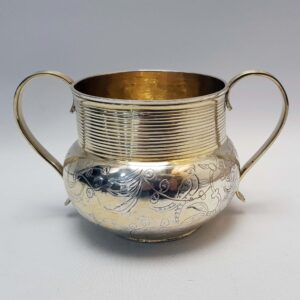
1678
Thomas Roman
10421 Charles II Antique Silver 2 Handled Cup
£8,750
This beautiful chinoiserie silver cup must be almost unique. The body is raised from sheet and has simple strap handles and an incised, reeded neck. This is similar in form to the earliest type of mug which was only made during a short period at the last quarter of the 17th century. The cup (or porringer?) is made completely by hand, and has a gilt silver finish. The body is stunningly decorated with a hand chased chinoiserie scene depicting exotic birds and plants in a tropical forest. Weight 254grams, 8.1 troy oz. Height 11cm (top of handle), 10.5cm (top of neck). Spread across the handles 18.5cm. Diameter 10.3cm. London 1678. Maker Thomas Roman. Sterling silver.
-

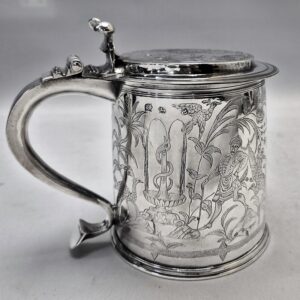
1678
10435 Charles II Antique Silver Tankard
£22,500
An exceptional example of early English chinoiserie silver. A finely engraved tankard with the flat hinged lid and “S” scroll handle typical of the period. Large size and good heavy weight. The body and lid are beautifully flat chased in the Chinese style with oriental figures, a snake-coiled fountain, a temple and exotic birds all within a fantastical forest landscape. The plain scroll is pricked with initials “B.I.M”. Contains 1500 ml. Weight 804g, 25.8 troy oz. Height 17.7cm (to top of thumb piece), 7ins. Spread 19.5cm, 7.7ins. Diameter 14cm (top), 5.5cm. London 1678. Maker “RH”. Sterling silver.